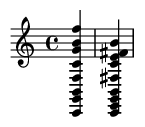Summary:
This article explores the rich and sophisticated world of the major eleventh chord (Maj11) . We'll uncover its unique theoretical construction, explain its characteristic dreamy yet dissonant sound, and demonstrate why its altered forms are essential in jazz, R&B, and film scoring. Learn how to build this chord, understand its relationship to the Lydian mode, and master practical voicings to add profound color and emotion to your music.
Keywords:
Major Eleventh, Maj11, Extended Chords, Chord Extensions, Music Theory, Harmony, Jazz Chords, Lydian Chord, Chord Voicing, Advanced Harmony, Avoid Note, Bill Evans, Steely Dan
Introduction:
Have you ever been stopped in your tracks by a chord in a song—a sound so lush, spacious, and emotionally deep it feels almost otherworldly? You may have been hearing an extended chord, a harmony that goes beyond simple triads. Among these, the major eleventh chord is one of the most captivating. It's a sound that can be both breathtakingly beautiful and startlingly dissonant, a sonic paradox that has fascinated composers from Claude Debussy to Herbie Hancock. Let's explore this chord and learn how to harness its unique power.
Definition: The Major Eleventh and its Built-in Problem
A major eleventh chord is a five-note chord built by stacking thirds on top of a major scale. Its formula is Root, Major Third, Perfect Fifth, Major Seventh, and Perfect Eleventh (1, 3, 5, 7, 11).
Let's take C Major. The scale is C-D-E-F-G-A-B. Building a C Major Eleventh (Cmaj11) gives us the notes: C (1), E (3), G (5), B (7), and F (11).
Herein lies the problem. The chord contains both a major third (E) and a perfect eleventh (F). These two notes are a minor second apart, one of the most dissonant intervals in music. When played together in the same octave, they create a harsh, jarring clash. Because of this inherent tension, the "pure" major eleventh chord is rarely used. Instead, musicians almost always use one of two elegant solutions.
The Two Solutions: How to Use the Major Eleventh
Musicians have developed two primary ways to resolve the Cmaj11's internal conflict and unlock its beauty:
1. Omit the 3rd: Maj11 (no 3rd). The simplest solution is to remove the major third (E). This eliminates the E-F clash entirely, resulting in a stable, open, and dreamy sound. A Cmaj11 (no 3rd) contains the notes C-G-B-F. This voicing is harmonically ambiguous and can be thought of as a G minor seventh chord over a C bass note (Gm7/C).
2. Sharpen the 11th: Maj7(#11). The most common solution in jazz is to raise the eleventh by a semitone, turning the "problematic" F into a "beautiful" F#. This transforms the clashing minor second (E-F) into a much more consonant major second (E-F#). The resulting chord is the Major Seventh Sharp Eleventh, or Cmaj7(#11): C-E-G-B-F#. This bright, magical-sounding chord is so common it's often called the "Lydian Chord," as it is naturally derived from the Lydian mode (a major scale with a raised fourth degree).
Examples: Hearing the Theory
Example 1: From Cmaj7 to the Cmaj11 "Clash"
This example shows a standard C Major Seventh chord in the first measure. In the second measure, we add the perfect eleventh (F). Listen to the dissonance created between the Major 3rd (E) and the Perfect 11th (F).

Example 2: Practical Voicings for Performance
Musicians rarely play chords stacked like pancakes. Here are two common, beautiful voicings that solve the dissonance problem. The first omits the 3rd, and the second uses the #11 "Lydian" solution. Notice how open and sophisticated they sound.

Practical Applications: Where You've Heard This Sound
The Maj7(#11) chord is a cornerstone of modern jazz harmony. Pianists and guitarists use its open, floating quality to create rich textures. Its dreamy nature makes it perfect for film scores evoking wonder, nostalgia, or vast landscapes—think of the work of composers like Thomas Newman. In the world of jazz-rock, Steely Dan famously built their sound on sophisticated harmonies, and the Maj7(#11) was a favorite color in their palette (related to their so-called "mu major" chord). For a definitive example, listen to the opening of Herbie Hancock's "Maiden Voyage," where the harmony is built almost entirely on these types of spacious, suspended chords.
Historical Figures: Pioneers of Harmonic Color
The seeds of the major eleventh's sound were planted long before jazz. French impressionist composers like Claude Debussy (1862-1918) and Maurice Ravel (1875-1937) moved away from traditional harmonic functions, using chords built on 9ths, 11ths, and 13ths to paint shimmering musical pictures. Their work directly influenced the jazz musicians who would later systematize these sounds. In the jazz world, pianist Bill Evans (1929-1980) was a master of harmony, renowned for his introspective and beautiful chord voicings, which often included complex extensions. His work on Miles Davis's "Kind of Blue" and his own trio recordings set a new standard for modern jazz piano, where chords like the Maj7(#11) became essential tools for expression.
Fun Facts: The "Avoid Note"
In jazz theory, the perfect eleventh in a major eleventh chord is famously labeled an "avoid note." This term applies to any scale degree that creates a strong clash with the essential notes of the chord (in this case, the major third). While "avoid" sounds like a strict prohibition, it's better understood as a "handle with care" label. It warns that holding this note out will create significant tension. Musicians might use it as a quick passing tone or embrace the dissonance for a specific, jarring effect. The entire concept of "avoid notes" is what led improvisers and composers to the elegant solution of sharpening the 11th, making the Maj7(#11) chord a celebrated sound rather than an avoided one.
Conclusions:
The major eleventh chord is a fascinating case study in musical harmony—a chord whose theoretical "flaw" gives rise to its most beautiful and useful variations. By understanding the tension within the pure Maj11, you can better appreciate why omitting the third or sharpening the eleventh unlocks such profound musical possibilities. These sounds have become staples in jazz, R&B, and film music for a reason: they are emotionally complex, sonically rich, and endlessly inspiring. The next time you sit down to play, experiment with these voicings. Move them around, hear them in different contexts, and discover the dreamy, sophisticated world they can open up in your own music.
References:
Levine, M. (1995). The Jazz Theory Book. Sher Music Co.
Russell, G. (2001). George Russell's Lydian Chromatic Concept of Tonal Organization. Concept Publishing.
Tymoczko, D. (2011). A Geometry of Music: Harmony and Counterpoint in the Extended Common Practice. Oxford University Press.
